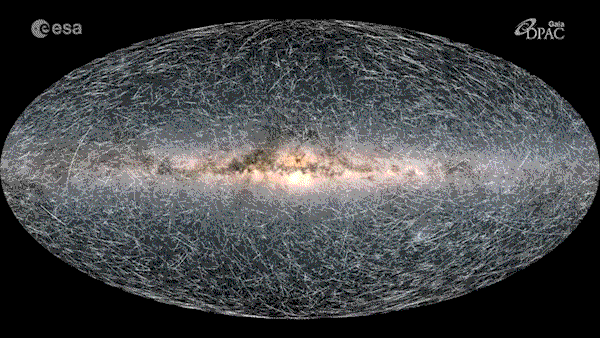Hello Nature readers, would you like to get this Briefing in your inbox free every day? Sign up here

A portion of a longer visualization based on Gaia data that shows how 40,000 stars in the Galaxy will move across the sky in the next 400,000 years.Credit: ESA/Gaia/DPAC; CC BY-SA 3.0 IGO. Acknowledgement: A. Brown, S. Jordan, T. Roegiers, X. Luri, E. Masana, T. Prusti and A. Moitinho.
Milky Way map has motion of a billion stars
A huge update of data from the Gaia space observatory offers a picture of what Earth’s night sky will look like for 1.6 million years to come. Gaia is tracking more than one billion stars in the Galaxy from a perch 1.5 million kilometres from Earth. The European Space Agency probe continuously scans the sky as it slowly spins on itself, tracking stars’ nearly imperceptible motions across the Galaxy year after year and triangulating their positions using parallax. The data will underpin studies that range from the origins and evolution of the Galaxy to locating its dark matter.
3,000 per year
Rate at which Gaia’s two previous data sets are now being cited in the literature.
First definitive ‘quantum advantage’
A team in China claims to have made the first definitive demonstration of ‘quantum advantage’ — exploiting quantum mechanics to perform computations that would be prohibitively slow on classical computers. The team achieved within a few minutes what would take half the age of Earth on the best existing supercomputers. Contrary to Google’s first demonstration of a quantum advantage, performed last year, their version is practically unassailable by any classical computer. “It is only a matter of time before quantum computers will leave classical computers in the dust,” says Christian Weedbrook, chief executive of quantum-computing startup Xanadu.
Execution reprieve for scientist in Iran
A medical researcher who was under threat of imminent execution in Iran has been granted a reprieve, reports The Guardian. Physician–scientist Ahmadreza Djalali, a scholar in disaster medicine who has dual Iranian–Swedish nationality, was sentenced to death in Iran three years ago on a charge of spying. Sweden, the United Nations and the global scientific community have pressured Iran to re-examine his case. It is not known whether the stay of execution is temporary or could lead to release, perhaps via a prisoner swap like the one that led to last month’s release of British-Australian academic Kylie Moore-Gilbert.
Read more: Alarm as execution looms for scientist on death row in Iran (Nature | 4 min read)
Features & opinion
How to write a superb literature review
Literature reviews are important resources, but few scientists are trained in how to write one. Old hands and first timers offer advice about how to make your reviews sing, and we compare the reference managers and collaborative writing tools that can help you get the job done.
Podcast: Vision regenerated in old mice
Researchers have restored vision in old mice and in mice with damaged retinal nerves by resetting some of the thousands of chemical marks that accumulate on DNA as cells age. The work suggests a new approach to reversing age-related decline: reprogramming some cells to a ‘younger’ state in which they are better able to repair or replace damaged tissue. The Nature Podcast investigates how it was done and whether the approach will translate to people.
Nature Podcast | 46 min listen
Subscribe to the Nature Podcast on Apple Podcasts, Google Podcasts or Spotify.
Books & culture
The grain that runs through human history
The Age of Wood is a lively history of biology, mechanics and culture that stretches back 60 million years. It ends in our sobering modern times of megafires and deforestation — but works hard to find rays of hope, writes reviewer Josie Glausiusz.
The demons and devils that haunt science
To conceptualize unseen forces, researchers have long invoked thought experiments involving demons, devils, golems or genies. Historian of science Jimena Canales sizes up imagined imps over the centuries and follows their impacts in her latest book, Bedeviled.
Futures: Watershed
Field scientists who study landscapes that were once peopled with long-dead others might sometimes imagine they walk alongside them. In Watershed, the latest short story for Nature’s Futures series, author John Gilbey ponders what subtle echoes or shadows of other times and realities might become detectable as we collect ever-increasing granularity of data.
